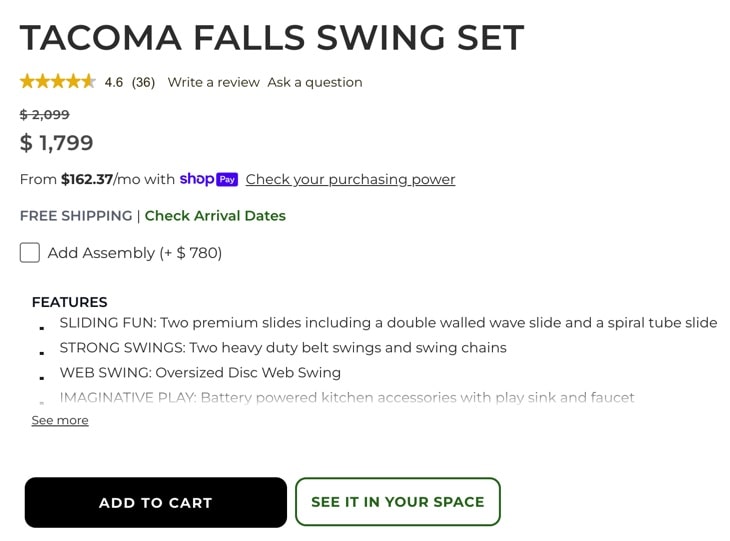Whether it’s encouraging add-to-carts, boosting email signups, or gaining product reviews, increasing conversions is the key to growing your ecommerce business. That means you need to constantly make changes that encourage consumers to take action or remove the obstacles that keep them from doing so.
But every change you make carries a risk. Will redesigning your website and rewriting copy drive more conversions? Or will it disrupt the conversions you’re already getting?
Making these changes can be nerve-wracking – but it doesn’t have to be. Rather than relying on guesswork, you can perform data-based conversion rate optimization using simple A/B tests to consistently increase your sales with confidence.
What is CRO?
Conversion rate optimization – known as CRO – is the process of using data to increase the percentage of users who take a desired action on your website.
For example, let’s say that one of your landing pages has a conversion rate of 2%. But you’ve heard that adding a video can significantly increase landing page conversions. So you create a second version of the page with a video embedded and divide traffic evenly between the two to compare performance. This is called A/B testing.
After 3 weeks, you see that the page without a video still has a conversion rate of around 2%. But the page with a video has a conversion rate of 3.6%! With proof that video leads to more conversions, you make these changes permanent.
You continue to perform A/B tests with different page layouts, call-to-action buttons, images, and copy blocks. And after 6 months of optimization, the conversion rate for your landing page has jumped to 6.2% – more than triple your starting rate!
By using analytics data to inform your changes, CRO lets you reliably trend your conversion rate upwards over time.
How to perform an ecommerce CRO audit with A/B testing
An ecommerce CRO audit involves assessing your website and the marketing channels pointing to it so you can find opportunities to boost your conversion rates.
But this isn’t a one-and-done project. You need to constantly test and monitor your changes to see what’s working and what’s not, and try a range of optimization strategies to maximize your conversion rate.
This ongoing process demands a lot of time and effort, which you might not be able to spare. That’s why many businesses rely on an ecommerce CRO agency like LimeLight Marketing. So if you’d like to maximize your revenue with proven CRO strategies for a fraction of the time and effort, contact us today.
Or, if you’d prefer to manage your optimizations in-house, follow these 6 steps for a successful ecommerce CRO audit.
1) Define your conversion goals
Start by deciding what actions you want your website users to take. This could be adding more to their cart, reducing cart abandonment, or signing up for a free trial.
Your analytics platform is a very useful tool for defining conversion goals. Look for any metrics that are performing below industry benchmarks or your company targets, and consider addressing these first.
2) Choose which pages to optimize
Once you’ve defined your goals, think about which pages are relevant to them. For example, optimized product pages are great for adding to cart. And a streamlined checkout process goes a long way to reducing cart abandonment.
3) Analyze customer behavior
Google Analytics and other platforms give you a wealth of information about how users behave on your ecommerce site. Knowing what pages get the most views, how users reach them, and on what pages they typically exit is valuable information for providing a seamless experience.
4) Form a conversion hypothesis
Using what you’ve learned from users’ shopping behavior, think about how you can change your target pages to better meet customers’ needs.
If a product isn’t selling well, it might be because people don’t trust it. So you could add a demo video, include positive reviews, or highlight a money-back guarantee.
In this case, your conversion hypothesis might be: “Adding a ‘30-day money-back guarantee icon’ will encourage users to click ‘add to cart’”.
5) Conduct A/B testing
A/B testing, also known as split testing, involves experimenting with two versions of a web page or other digital asset to compare which performs better.
Before you start your A/B test, gather and record data on how well your current page is performing. Then set up another version of that page with a change based on your conversion hypothesis, and split traffic evenly between the test and control pages.
Continue monitoring the performance of both pages until you have enough data to show whether your change increased, decreased, or didn’t affect your conversion rate.
It’s important that you only ever A/B test one element at a time. If you test more than one, you won’t know which change is having an effect!
6) Implement permanent changes
The analytics data you collected during your A/B test will tell you whether or not your hypothesis was correct.
If it was and your conversion rate increased, make that change permanent.
If it wasn’t and your conversion rate dropped or remained the same, try something else.
The data you gather across all A/B tests will inform your next ecommerce CRO audit, helping you trend toward higher conversion rates across your site.
How LimeLight Marketing used A/B testing to increase add-to-carts by 2.3%
As an established ecommerce CRO agency, we use A/B testing to continually optimize conversion rates for our clients. That includes one of our biggest clients, Backyard Discovery, a retailer of gazebos, pergolas, and other backyard leisure products based in Pittsburg, KS.
(If you follow our work, you might have already read about how we’ve helped them achieve page 1 rankings on Google and more than double their online sales with a website redesign!)
Our A/B tests for Backyard Discovery have included:
- Adding short descriptions and specific callouts
- Adding or removing buttons
- Changing the locations of images and icons
- Adding or removing copy blocks
- Trialing different language (e.g. ‘free shipping’ vs ‘shipping included’)
One of our most recent tests was very simple. All we did was change the color of the ‘add to cart’ buttons on their product pages.
Previously, these buttons had been green. But since this is Backyard Discovery’s primary brand color, there was a risk that the buttons weren’t standing out.
Our goal was: ‘Increased add to carts’.
And our conversion hypothesis was: ‘Making the ‘add to cart’ button black will make it stand out and elicit more clicks’.
In just 11 days, Backyard Discovery experienced a notable 2.3% increase in add-to-cart conversions with just this one small change!

Accelerate your sales by partnering with a leading ecommerce CRO agency
Our ecommerce CRO audit with Backyard Discovery has the potential to generate tens of thousands of dollars of additional revenue every year. And for them it was literally effortless!
You have the same opportunity to optimize your conversions and maximize your income. Simply get in touch with LimeLight Marketing today and let our leading ecommerce CRO agency bring you additional sales.



